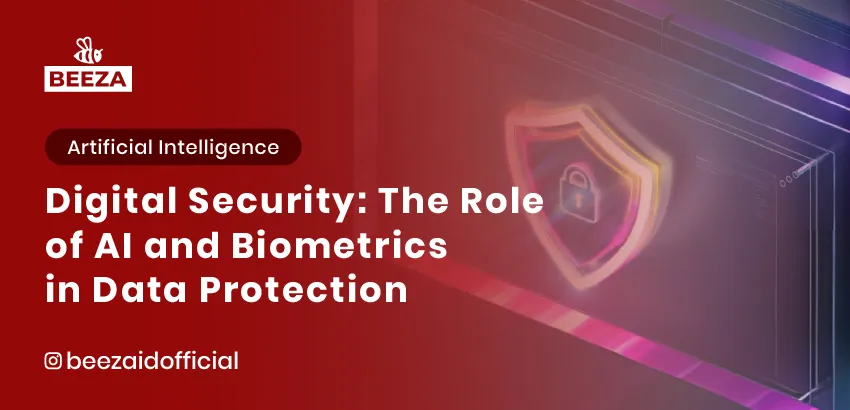
As the digital landscape evolves, data security has become more crucial than ever. With the growing volume of data being stored online and the rise of cyber threats, safeguarding sensitive information is a priority for both individuals and organizations. Two technologies that will significantly shape the future of digital security are Artificial Intelligence (AI) and biometrics. These innovations are playing a pivotal role in data protection, ensuring that personal and business data is shielded from emerging threats.
In this article, we’ll explore how AI and biometrics will shape the future of digital security and why they are essential in protecting our data.
What Are AI and Biometrics?
Artificial Intelligence (AI)
AI, or Artificial Intelligence, refers to technology that allows machines to mimic human intelligence. With AI, systems can learn from data, recognize patterns, and make decisions autonomously. In digital security, AI is used to detect threats more quickly and effectively, providing a more robust defense against cyberattacks.
Biometrics
Biometrics refers to technologies that use unique physical or behavioral characteristics to identify and verify individuals. Examples of biometrics include fingerprints, facial recognition, retina scanning, and voice recognition. This technology is crucial for enhancing security and providing a safer, more efficient way to access systems or data.
The Role of AI in Digital Security
1. Automated Threat Detection
AI enables systems to analyze vast amounts of data and detect patterns that may indicate a potential threat. Machine learning algorithms can be trained to recognize common types of attacks, such as phishing, ransomware, or DDoS attacks, and send early warnings to prevent further damage.
Example:
A bank that uses AI to monitor customers’ transactions in real-time can immediately detect suspicious activity, alerting the customer or even blocking the transaction before any loss occurs.
2. Smarter Security Monitoring
AI also allows for more intelligent surveillance using technologies like facial recognition to monitor access to sensitive areas. AI-powered systems can verify someone’s identity based on their facial features and compare it to pre-existing data.
Example:
A large corporation using AI-powered surveillance in sensitive areas like server rooms or data centers ensures that only authorized personnel can enter, reducing the risk of data breaches due to unauthorized access.
3. Automated Response to Threats
In critical situations, AI can speed up the response to a threat. For instance, when a cyberattack is detected, AI can isolate the affected systems and prevent further spread without human intervention. This accelerates problem resolution and minimizes the damage caused by the attack.
Example:
If a ransomware attack is detected, an AI-based system can immediately disconnect infected systems from the network and isolate the affected files, stopping the malware from spreading.
The Role of Biometrics in Digital Security
1. More Secure User Authentication
Biometrics offers a far more secure way to authenticate users compared to traditional methods like passwords, which can be compromised or forgotten. Facial recognition, fingerprints, and voice recognition provide a safer and more reliable method of verifying identity.
Example:
A banking app that uses facial recognition to log in allows customers to access their accounts without needing to remember a password, reducing the risk of hacks due to weak or leaked passwords.
2. Physical Security and Access Control
Biometrics aren’t just used for digital access but also for physical access to sensitive facilities. Using fingerprints or facial recognition, organizations can ensure that only authorized individuals are allowed access to data centers, server rooms, or confidential storage areas.
Example:
A tech company using facial recognition to grant access to its data center ensures that only authorized staff can enter, reducing the risk of data theft or leaks.
3. Reducing Fraud and Identity Theft
Because every individual has unique physical traits, biometrics is highly effective in preventing identity theft. In e-commerce or fintech applications, biometric verification ensures that transactions are made by the legitimate account holder, minimizing fraud risks.
Example:
A fintech platform using facial recognition to verify online payments ensures that the person making the transaction is the account holder, reducing the risk of fraud.
The Future of Digital Security: Trends in AI and Biometrics
1. Advanced AI for Anomaly Detection
In the future, AI in digital security will become even more sophisticated, with the ability to detect behavioral anomalies. By analyzing user behavior patterns, systems can identify unusual activities that may indicate a threat, such as an account suddenly logging in from a foreign location.
2. Multi-Factor Biometric Authentication
Moving forward, multi-factor biometric authentication will become more common. This means that users will be required to verify their identity using multiple biometric methods simultaneously, such as facial recognition and fingerprints, for higher security levels.
3. Predictive Security with AI
AI will also evolve to offer predictive capabilities in data security. By analyzing massive datasets and identifying potential threat patterns before they happen, AI will help prevent cyberattacks before they can cause significant damage.
Conclusion
AI and biometrics are playing a critical role in shaping the future of digital security, especially in terms of data protection. With these technologies, we can expect faster threat detection, stronger authentication methods, and enhanced physical security, all contributing to a safer digital environment.🌐 Are you ready to implement AI and biometrics in your digital security systems?
Contact Beeza for cutting-edge digital security solutions to protect your data. Learn more today.